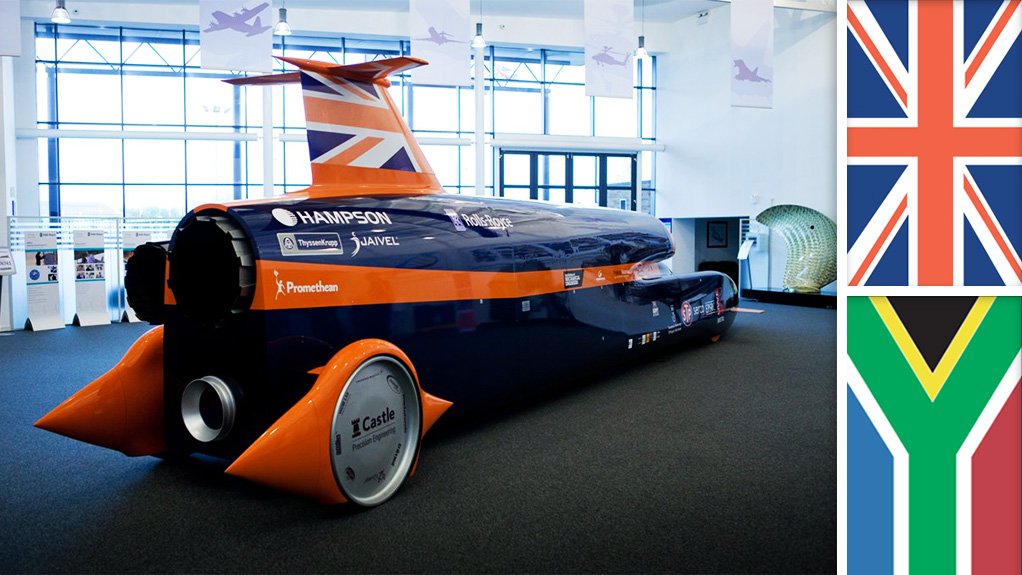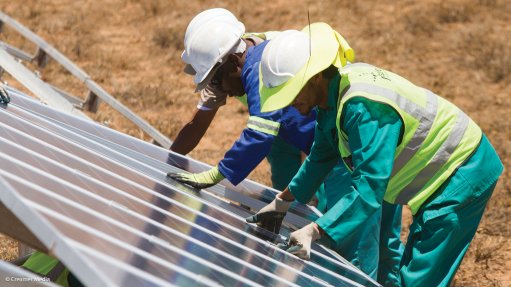Bloodhound supersonic car project, UK and South Africa
Name of the Project
Bloodhound supersonic car (SSC) project.
Location
UK and South Africa's Northern Cape province.
Client
Founder sponsors include Swansea University, the Engineering and Sciences Research Council, the Serco group, the University of the West of England and STP.
Project Description
The project involves the construction of, possibly, the world’s fastest car.
The SSC is an amalgamation of car and aircraft technology, with the front half being a carbon-fibre monocoque, similar to that of a racing car, and the back half being a metallic frame, with panels like those of an aircraft. It is expected to reach a speed of more than 1 600 km/h.
The Bloodhound will have a slender, 14-m-long body, with two front wheels mounted within the body and two rear wheels mounted externally within the wheel fairings.
Jobs to Be Created
Not stated.
Value
R515-million.
Duration
The Bloodhound is expected to make its 1 609 km/h run in 2018.
Latest Developments
The Bloodhound supersonic car is expected to be transported to South Africa in October.
Following the Bloodhound’s successful 320 km/h runway trial at Cornwall Airport, Newquay, in the UK, in October last year, the team will target 800 km/h as the next milestone in its attempt to break the current land-speed record of 1 227.98 km/h set in 1997.
The ultimate hope is to reach 1 000 mph, or 1 609 km/h.
The dry lake-bed race track chosen for the record attempt is at Hakskeen Pan, in the Northern Cape.
The Bloodhound 500 trials will aim to test the car’s performance and handling during one of its most vulnerable phases – the point between 640 km/h and 800 km/h, where the stability of the car transitions from being governed by the interaction of the wheels with the desert surface to being controlled by the vehicle’s aerodynamics.
The grip from the wheels will fall off faster than the aerodynamic forces build-up, so this is likely to be the point where the Bloodhound is at its least stable.
Data on the interaction between the solid aluminium wheels, which will be used for the first time, coupled with base drag measurements, will provide real-world insight into the power required to set the record.
Base drag relates to the aerodynamic force produced by low pressure at the rear of the car, sucking it back.
As the car approaches transonic speeds, this force far exceeds the friction of the air passing over the Bloodhound’s bodywork.
The car’s wheels have been specially designed for the desert surface. Measuring 900 mm in diameter and weighing 95 kg each, they are designed to spin at up to 10 200 rpm – more than four times faster than wheels on an F1 car at top speed.
The result of 30 years of research and design, they were created by an international consortium and forged from one of the highest aircraft-grade aluminium alloys in the world – 7037.
The wheels have a V-shaped keel that should dig 25 mm into the alkali playa (baked mud) surface of Hakskeen Pan when the car is stationary.
As speeds increase, the wheels will rise up out of the mud surface, in much the same way as a speedboat rides up on the surface of the water.
At 804 km/h and above, just a few millimetres of metal will be in contact with the desert surface, and the giant alumimium discs will act more like rudders than the wheels on a conventional car.
The Bloodhound 500 tests will be conducted using the car’s Rolls-Royce EJ200 jet engine, normally fitted in a Eurofighter Typhoon, which produces a peak thrust of 90 kN, equivalent to 54 000 thrust hp, or the combined output of 360 family cars.
“The track is 19 km long and 500 m wide, with large safety areas on both sides,” Bloodhound engineering director Mark Chapman has said.
“This allows us to lay out up to 50 individual tracks side by side. This is important, as we can’t run over the same piece of ground twice, because the car will break up the baked mud surface as it passes.
“We need multiple tracks so we can build speed slowly and safely – going up in 80 km/h steps, comparing real-world results with theoretical data – and Hakskeen Pan is the perfect place to do this.
“The surface is hard, which means we’ve been able to design slightly narrower wheels that reduce aerodynamic drag. The desert surface also has a slight degree of ‘give’, which will work with the suspension to give a smoother ride, reducing vibration inside the car.”
During the Bloodhound 500 tests, hundreds of gigabits of information will be gathered by more than 500 sensors built into the car.
This will not just be used by the Bloodhound team, but will be shared with schools worldwide, owing to the project’s cloud computing partner, Oracle.
Students will be invited to analyse the data and mark the engineers’ ‘homework’ in real time, as part of the project’s aim to further interest in science, engineering and mathematics.
In a continued effort to raise funds, the not-for-profit Bloodhound project is inviting supporters to join them at the trials. A limited number of places are available for prebooking at http://www.bloodhoundssc.com/bloodhound500.
Guests will visit the desert technical centre, attend team briefings and meet driver Andy Green, who is also the current land-speed record holder.
Key Contracts and Suppliers
Castrol (lubricants, brake and hydraulic fluids), Poynting (antennas).
On Budget and on Time?
The land-speed record attempt has been postponed to 2018. Initially planned for 2015, the UK-driven record attempt has faced a number of deferments, owing largely to budgetary constraints.
Contact Details for Project Information
Mettle PR, on behalf of Bloodhound, Jules Tipler, tel +44 7811 166 796 or email jules.tipler@mettlepr.com.
Comments
Press Office
Announcements
What's On
Subscribe to improve your user experience...
Option 1 (equivalent of R125 a month):
Receive a weekly copy of Creamer Media's Engineering News & Mining Weekly magazine
(print copy for those in South Africa and e-magazine for those outside of South Africa)
Receive daily email newsletters
Access to full search results
Access archive of magazine back copies
Access to Projects in Progress
Access to ONE Research Report of your choice in PDF format
Option 2 (equivalent of R375 a month):
All benefits from Option 1
PLUS
Access to Creamer Media's Research Channel Africa for ALL Research Reports, in PDF format, on various industrial and mining sectors
including Electricity; Water; Energy Transition; Hydrogen; Roads, Rail and Ports; Coal; Gold; Platinum; Battery Metals; etc.
Already a subscriber?
Forgotten your password?
Receive weekly copy of Creamer Media's Engineering News & Mining Weekly magazine (print copy for those in South Africa and e-magazine for those outside of South Africa)
➕
Recieve daily email newsletters
➕
Access to full search results
➕
Access archive of magazine back copies
➕
Access to Projects in Progress
➕
Access to ONE Research Report of your choice in PDF format
RESEARCH CHANNEL AFRICA
R4500 (equivalent of R375 a month)
SUBSCRIBEAll benefits from Option 1
➕
Access to Creamer Media's Research Channel Africa for ALL Research Reports on various industrial and mining sectors, in PDF format, including on:
Electricity
➕
Water
➕
Energy Transition
➕
Hydrogen
➕
Roads, Rail and Ports
➕
Coal
➕
Gold
➕
Platinum
➕
Battery Metals
➕
etc.
Receive all benefits from Option 1 or Option 2 delivered to numerous people at your company
➕
Multiple User names and Passwords for simultaneous log-ins
➕
Intranet integration access to all in your organisation





















